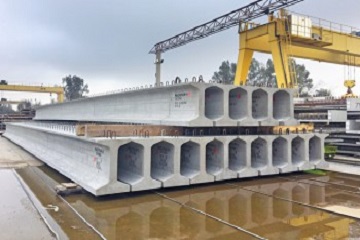Precast Construction Technology is focused on the improvement of value and quality in the Precast manufacturing and construction industry. This technology is meeting the demand of challenging modular projects.
Table of Contents
Precast Construction Technology
It is a system of concrete casting in a reusable mold or form which is then treated in a controlled environment, shifted to the construction sites, and lifted to the place. Precast construction technology consists of various precast elements such as walls, beams, slabs, columns, staircase, landing, and some customized elements that are designed for the stability and durability of the building.

Precast residential buildings involve the design, planning, lifting, handling, and transport of precast elements. This technology is suitable for the construction of high-rise buildings resisting seismic and wind-induced lateral loads with gravity loads. In factory-controlled conditions, these elements are cast.
Precast Concrete Element
Concrete components of a building are prefabricated in the precast yard or site and shall be installed in the building during construction.
Types of Precast Elements
There are two types of precast concrete elements as follows:
- Precast reinforced concrete elements.
- Precast prestressed concrete elements.
1. Precast Reinforced Concrete Elements:
This shall consist of reinforcement bars or welded wire meshes within the element to provide the structural strength as needed such as façade walls, beams, columns, slabs, staircase, and parapet wall.
2. Precast Pre-Stressed Concrete Elements:
These shall consist of pre-stressing tendons within the elements to provide a predetermined force needed to resist external loadings and cracks such as beams, hollow core slabs, planks, etc.
Following are some precast components.
- Wall panels.
- Beams.
- Hollow core slabs.
- Staircase.
- Columns.
Advantages Of Precast Construction
1. Construction Speed
Precast elements are manufactured in a controlled environment and can be quickly installed on site, thus reducing construction timelines.
2. Cost Effective
Prefabricated construction is a cost effective method of building construction as it reduces construction time, labor cost and maintenance cost in the long run.
3. Quality Control
Precast items are manufactured in a controlled environment with strict quality control procedures. This ensures high quality products free from defects.
4. Minimize site downtime
Precast elements are manufactured off-site and only need to be transported and installed at the construction site, thus minimizing on-site downtime.
5. Durability
Precast elements are designed to be durable and long-lasting, reducing the need for frequent repairs or replacements.
6. Sustainability
Prefabricated construction reduces the amount of waste generated on the construction site, making it a sustainable option.
7. Flexibility
Precast elements can be designed and manufactured to any shape or size, making them a flexible solution for any construction project.
8. Fire Resistance
Prefabricated elements are made of non-combustible materials and have excellent fire resistance properties, making them a safe choice for buildings.
9. Weather resistance
Prefabricated elements can withstand harsh weather conditions, making them a suitable choice for buildings in areas prone to natural disasters.
10. Design Freedom
Precast elements can be designed for a range of textures, colors, and finishes, giving designers the freedom to create unique and attractive buildings.
Disadvantages Of Precast Construction
1. High Initial Investment
Construction of prefabricated buildings requires a large initial investment in the form of manufacturing equipment, molds, and warehousing facilities.
2. Limited location flexibility
Precast elements are manufactured off-site, which limits the ability to make design changes or modifications once the manufacturing process has begun.
3. Transportation and logistics:
Precast items can be heavy and require specialized transportation, which can add to the overall cost and logistical challenges.
4. Skilled Labor Required
Precast construction requires skilled workers who handle the fabrication and installation of the elements, which can increase labor costs.
5. Design Limitations
There are limitations on the size and shape of prefabricated items that can be manufactured, which may restrict design possibilities for some projects.

